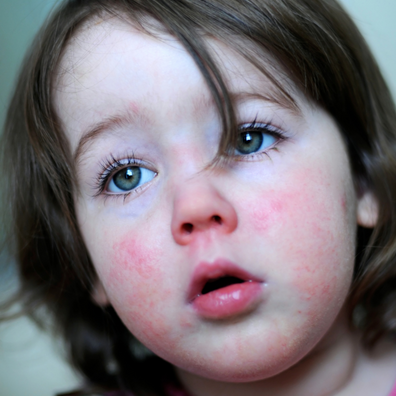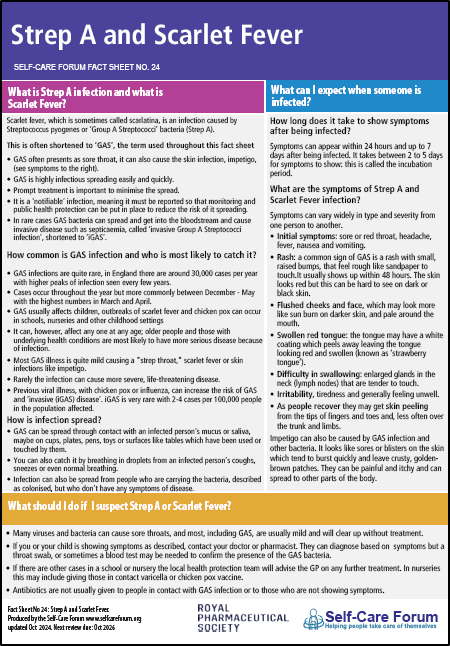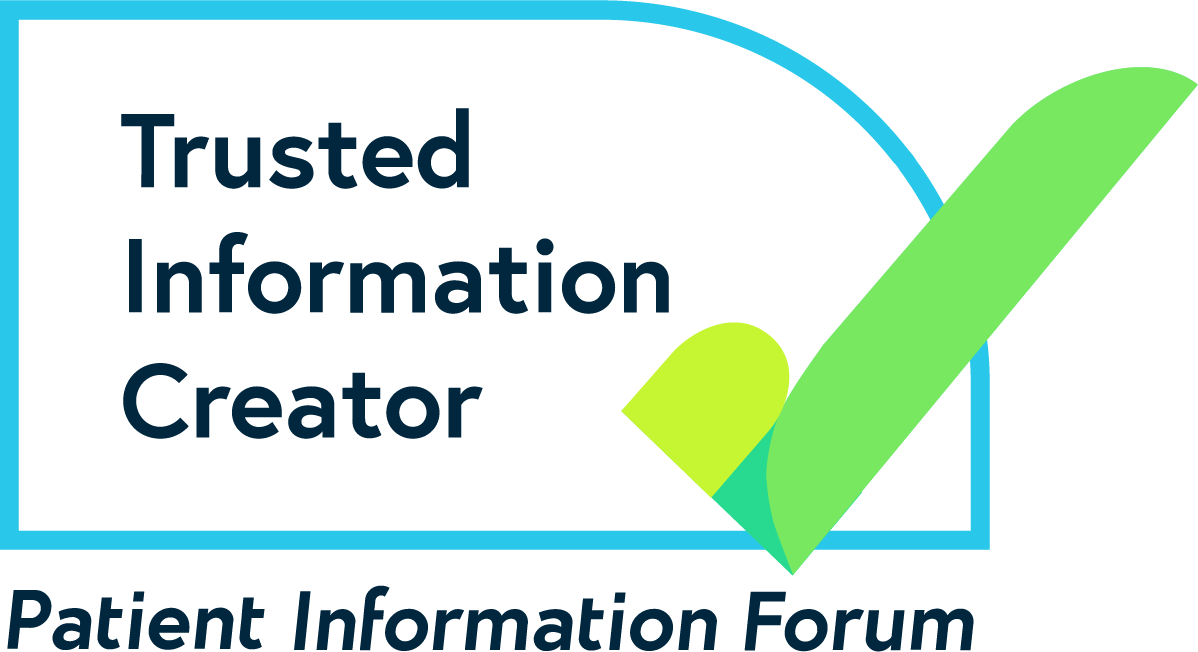This fact sheet helps you to know what’s ‘normal’ and what you can expect to happen if you or a child develops Strep A or Scarlet Fever. It also tells you when you should become concerned and seek medical advice from a health professional.
Useful facts
What is Strep A Infection and what is Scarlet Fever?
Scarlet fever, which is sometimes called scarlatina, is an infection caused by Streptococcus pyogenes or ‘Group A Streptococci’ bacteria (Strep A).
This is often shortened to ‘GAS’, the term used throughout this fact sheet.
• GAS often presents as sore throat, it can also cause the skin infection, impetigo, (see “what can i expect when someone is infected?”).
• GAS is highly infectious spreading easily and quickly.
• Prompt treatment is important to minimise the spread.
• It is a ‘notifiable’ infection, meaning that it must be reported so that monitoring and public health protection can be put in place to reduce the risk of it spreading.
• In rare cases GAS bacteria can spread & get into the bloodstream & cause invasive disease such as septicaemia, called ‘invasive Group A Streptococci infection’, abbreviated to ‘iGAS’.
How common is GAS infection and who is most likely to catch it?
• GAS infections are quite rare, in England there are around 30,000 cases per year with higher peaks of infection seen every few years.
• Cases occur throughout the year but more commonly between December – May with the highest numbers in March and April.
• GAS usually affects children, outbreaks of scarlet fever and chicken pox can occur in schools, nurseries and other childhood settings
• It can, however, affect any one at any age; older people and those with underlying health conditions are most likely to have more serious disease because of infection.
• Most GAS illness is quite mild causing a “strep throat,” scarlet fever or skin infections like impetigo.
• Rarely the infection can cause more severe, life-threatening disease.
• Previous viral illness, with chicken pox or influenza, can increase the risk of GAS and ‘invasive (iGAS) disease’. iGAS is very rare with 2-4 cases per 100,000 people in the population affected.
How is infection spread?
• GAS can be spread through contact with an infected person’s mucus or saliva, maybe on cups, plates, pens, toys or surfaces like tables which have been used or touched by them.
• You can also catch it by breathing in droplets from an infected person’s coughs, sneezes or even normal breathing.
• Infection can also be spread from people who are carrying the bacteria, described as colonised, but who don’t have any symptoms of disease.
What can I expect when someone is infected?
How long does it take to show symptoms after being infected?
Symptoms can appear within 24 hours and up to 7 days after being infected. It takes between 2 to 5 days for symptoms to show: this is called the incubation period.
What are the symptoms of Strep A and Scarlet Fever infection?
Symptoms and their severity can vary considerably from person to person.
- • Initial symptoms: sore or red throat, headache, fever, nausea and vomiting.
• Rash: a common sign of GAS is a rash with small, raised bumps, that feel rough like sandpaper to touch.It usually shows up within 48 hours. The skin looks red but this can be hard to see on dark or black skin.
• Flushed cheeks and face, which may look more like sun burn on darker skin, and pale around the mouth.
• Swollen red tongue: the tongue may have a white coating which peels away leaving the tongue looking red and swollen (known as ‘strawberry tongue’).
• Difficulty in swallowing: enlarged glands in the neck (lymph nodes) that are tender to touch.
• Irritability, tiredness and generally feeling unwell.
• As people recover they may get skin peeling from the tips of fingers and toes and, less often over the trunk and limbs.
Impetigo can also be caused by GAS infection and other bacteria. It looks like sores or blisters on the skin which tend to burst quickly and leave crusty, golden-brown patches. They can be painful and itchy and can spread to other parts of the body.
What should I do if I suspect Strep A or Scarlet Fever?
• Many viruses and bacteria can cause sore throats, and most, including GAS, are usually mild and will clear up without treatment.
• If you or your child is showing symptoms as described, contact your doctor or pharmacist. They can diagnose based on symptoms but a throat swab, or sometimes a blood test may be needed to confirm the presence of the GAS bacteria.
• If there are other cases in a school or nursery the local health protection team will advise the GP on any further treatment. In nurseries this may include giving those in contact varicella or chicken pox vaccine.
• Antibiotics are not usually given to people in contact with GAS infection or to those who are not showing symptoms.
Treatment & Antibiotics
If a diagnosis of GAS is made, a course of antibiotics will be prescribed
• Symptoms will subside quickly after starting the course, it is important to complete the full course.
• Antibiotics will reduce the time the person is infectious and able to pass on the disease.
• If scarlet fever is not treated the symptoms can persist for 2 – 3 weeks and people will remain infectious. Most people will no longer be infectious after 24 hours from starting the antibiotics.
• To limit the spread of infection, you should keep away from school or work for at least 24 hours after starting the antibiotics.
• Those who decline treatment with antibiotics must stay away from school or work until their symptoms have gone.
• If for some reason you do not complete the course of antibiotics, dispose of unused medicines by taking them to your pharmacy.
When should I seek medical attention?
For most people GAS infection does not cause complications but they can occur in the early stages of infection:
- Local infections; ear infection, throat abscess, inflammation of the sinuses (sinusitis), skin or soft tissue infection (cellulitis).
- Invasive disease; pneumonia, joint inflammation (arthritis), septicaemia, meningitis
Late effects of Scarlet Fever
- Very rarely people can develop complications at a later stage such as: bone or joint problems, liver damage, kidney damage and heart damage.
- It is important therefore to keep an eye out for any symptoms which might suggest these complications in the first few weeks after the main infection has cleared up.
- For any persistent severe symptoms: joint pain, palpitations breathlessness, seek medical help immediately.
Invasive Group A streptococcal disease (iGAS)
- Early signs and symptoms of iGAS disease include: High fever, severe muscle aches, localised muscle tenderness, increasing pain, swelling & redness at site of wound & unexplained diarrhoea or vomiting.
- Seek urgent help and advice if these symptoms occur and household contacts who are also at risk of infection should also say they have been exposed to GAS infection.
What can I do to help now & in the future?
Minimise the spread of infection in schools and workplaces
Children and adults can continue to attend school or work as normal unless they are feeling unwell and have a high temperature.
Good infection prevention and control
Infection is spread through contact with an infected person or any contaminated objects.
The following measures are essential to reduce the risk of infection to yourself & protect those around you. It is important to teach children – the e-bug resources are useful for this.
- • Ventilation: try to stay out of crowded spaces. Make sure there is good air flow by keeping windows open where possible.
• Respiratory hygiene: cover your nose and mouth with a tissue when you cough or sneeze. Throw the tissue away and wash your hands. If you don’t have a tissue, cough or sneeze into your inner elbow, not into your hand.
• Avoid touching your eyes, mouth and nose with contaminated hands, this risks re-infection.
• Make sure hands are thoroughly cleaned after contact with coughs or sneezes or any potentially contaminated objects and materials.
• Hand washing or use of alcohol gel. Wash hands before and after eating, after going to the toilet or after touching any infected areas such as skin rash, after coughing or touching the face.
• General cleaning of plates cups and toys etc and careful handling of soiled household items like bedding, and towels will reduce the risk of cross- infection.
Get prompt treatment and complete the course.
• If you or your child is showing symptoms as described contact your GP Practice or pharmacy and get antibiotics as soon as possible.
• It is very important that the full course of antibiotics is taken to reduce the risk of reinfection or of different strains of GAS developing.
Where can I find out more?
E-bug: Teaching children about hygiene
UKHSA: Scarlet fever: symptoms, diagnosis and treatment
NHS: Is my child too ill for school?
UKHSA: Preventing and controlling infections
NHS: Impetigo
UKHSA: Guidelines for the public health management of scarlet fever outbreaks in schools, nurseries and other childcare settings.
We review our health information every two years and this information is due to be updated in October 2026.
Huge thanks to the Royal Pharmaceutical Society for commissioning this self-care aware fact sheet.




